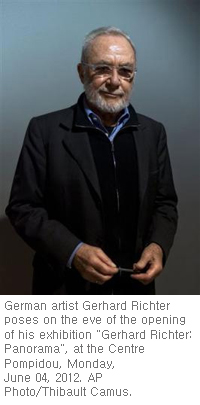By THOMAS ADAMSON
Gerhard Richter opens largest exhibit in Paris

PARIS.- Gerhard Richter, one of the world's top-selling living artists, launched his largest exhibit to date in Paris on Monday — a show spanning six decades of a diverse and storied career.
"Panorama," which opens to the public on Wednesday, sprawls the entire sixth floor of the Pompidou Center; it features some 141 paintings in 10 rooms that start from the geometric abstract pieces from the 1960s right up to the digital printing that ends in 2011.
But for an artist whose 2011 auction sales totaled $200 million, according to auction tracker Artnet, what can Paris give him that he's not already got? For the German-born artist, it's all down to the space.
Though a reduced version of the exhibit has already been seen in London and Berlin, works added from French national archives make this the largest display in the painter's history.
Richter said the Pompidou was uniquely ideal thanks to its "very generous space."
Though Richter is normally uncomfortable around journalists — he stormed out of a press conference last year in London — he opened up to the press Monday in at the Pompidou Center, joking that despite money and fame, "No!" he does not consider himself a rock star.
To understand the exhibit's title, look no further that the central glass sculpture entitled "6 Standing Panes," which serves as a looking-glass onto the landmark building's bird's eye view of Paris.
"This panorama it has a completely new dimension!" said one viewer, Marie Tremoulet.
Richter started out as Europe's answer to American Pop Art, commenting on his continent's consumer culture.
Equally however, Richter — who lived through World War II — was known for his attacks on Germany's Nazi past: from photographs of aerial invasions in 1964 to the disturbing 2000 work "Uncle Rudi," in which he dresses his uncle up in Nazi uniform.
The dark atmosphere is also present in his many portraits, including a picture of his mentally fragile aunt Marianne — showing her with Richter as a child, before she was killed by Germans.
His gray period is equally gloomy, represented as a series of eight monochrome tableaux.
"Gray is the color ... the most important of all ... absent of opinion, nothing, neither/nor," Richter said with signature cynicism.
He was said to have painted these works in a period of personal and professional uncertainty and unhappiness.
In stark contrast to this is the series entitled "Releasing Abstraction," in which Richter's glum imagery gives way to bursts of color in the form of large, bright canvas works from the 1980s.
"Glenn" and "June" — both works taken from French archives — feature vivid reds, blues and yellows painted in different layers and at different times. Richter calls it "a highly planned kind of spontaneity."
Clearly savoring the momentary positivity, curator Camille Morineau called it her favorite part of the collection: "It's a real explosion of joy. He was happy when he painted them."
Another source of joy for Richter was fatherhood.
Intimate works such as "S. with Child" — based on his wife with their newborn child — seem even more striking in their contrast with the glass and digital works, which distance the spectator from the artist in their neutrality.
"I have painted my family so frequently because they are the one who really affect me the most," said Richter.
Despite links to his family and the past, Richter remains thoroughly engaged in the world around him.
His final work, "Strips" from 2011, which caps the exhibit, explores how traditional painting can be reconciled with the rise of digital culture.
Richter celebrated his 80th birthday in February — but with more projects in the pipeline, it seems he has no intention of letting age slow him down.
FAMILY SITE
copyright © 2012 KIM DALJIN ART RESEARCH AND CONSULTING. All Rights reserved
이 페이지는 서울아트가이드에서 제공됩니다. This page provided by Seoul Art Guide.
다음 브라우져 에서 최적화 되어있습니다. This page optimized for these browsers. over IE 8, Chrome, FireFox, Safari